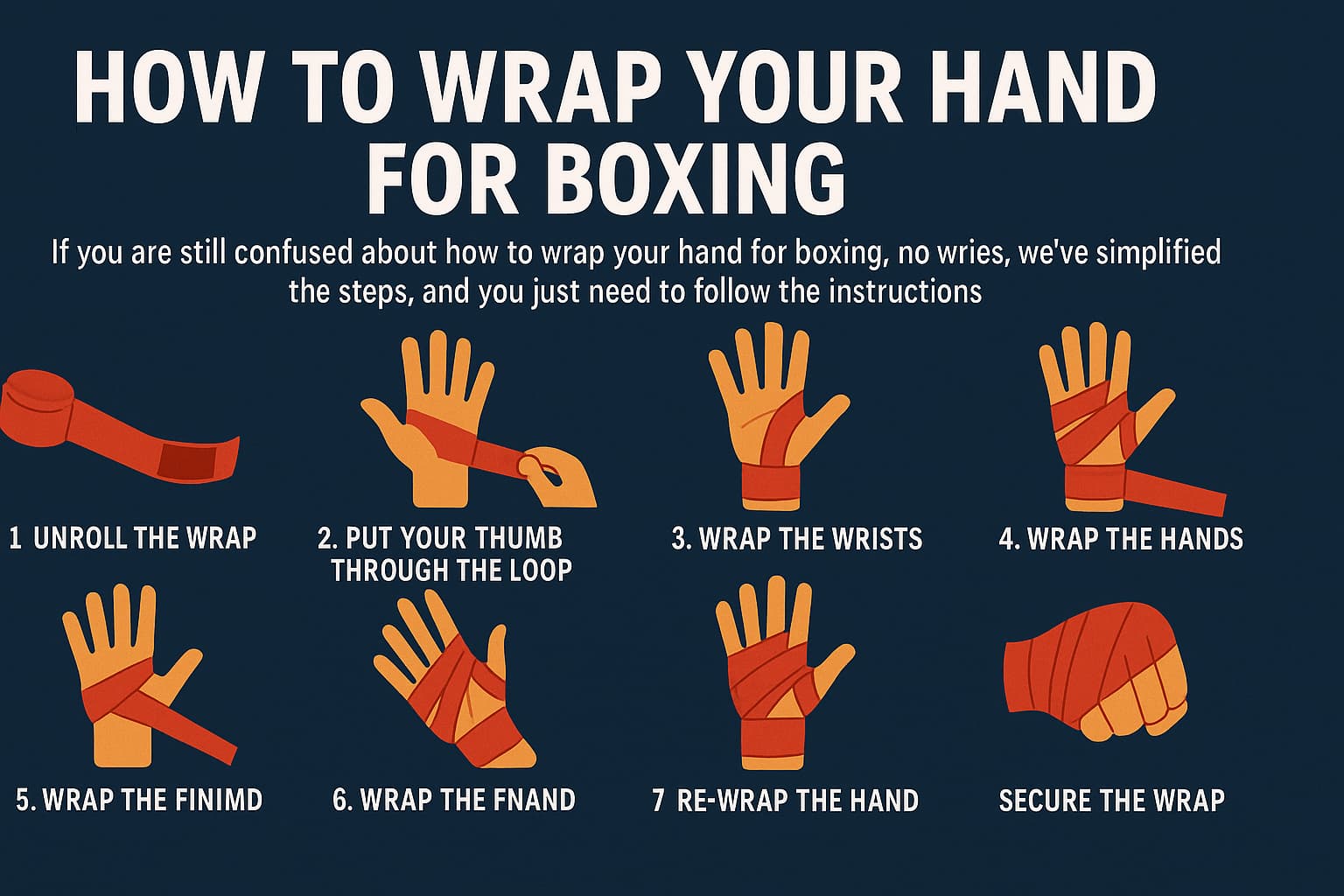Every boxer (from novice to advanced) needs to know how to wrap their hands properly before training or in a match. Hand wrap is an essential part of boxing gear used to ensure your safety, as not wearing or not wrapping your hands properly could lead to injury in a few spots, like the knuckles and wrists. Other than that, wrapping your hands properly could support small bones and tendons and boost your punch.
Sadly, not every boxer knows how to wrap their hands properly. Here are a few steps and a guide on how to wrap your hands before a boxing practice or match to ensure everything is fine and you don’t end up with an injury.
Why Hand Wrapping Matters in Boxing
One thing you need to do before putting on your boxing gloves is to wrap your hands. Your hands are made up of small bones and tendons, which makes it risky if they’re injured, and will leave you unable to move your hands for quite a long time.
Without proper protection, your hands could be sprained. The risk of sprains, fractures, and long-term damage increases.
Here’s why you should wrap your hands properly
- Support your wrists during punches
- Protect the knuckles from cuts and bruises
- Keep the bones in your hands stable
- Prevent severe hand injuries
In addition to that, wrapping your wrist will also reduce the excess sweat from your hands and palm to the boxing gloves.
What You Will Need Before Wrapping Your Hands
Before you begin wrapping your hands, you will need to prepare a few things.
Hand Wraps
Choose wraps that are 180 inches long for adults. Shorter options work better for kids or smaller hands.
Clean, Dry Hands
Start with hands free from sweat, lotion, or dirt to ensure wraps stay in place and feel comfortable.
Gauze and Tape (Optional)
Used by pros, gauze and athletic tape offer maximum protection, but are not necessary for beginners.
Mirror
Use a mirror while wrapping your hands to check technique and make adjustments as you learn.
Comfortable Material
Pick cotton wraps with slight elasticity so they breathe well, stretch slightly, and provide a secure fit.
How to Wrap Your Hand For Boxing

If you are still confused about how to wrap your hand for boxing, no worries, we’ve simplified the steps, and you just need to follow the instructions.
Step 1: Unroll the Wrap
First things first, you will need to unroll the hand wrapper you’ve chosen. One end will have Velcro, and the other will have a loop for your thumb.
Most wraps have a sign to show which side goes down. If not, check which side the Velcro is on to wrap it the right way.
Step 2: Put Your Thumb Through the Loop
Stretch your hands with the wrists out and make sure to spread your fingers. Then, place your thumb through the hole at the end of the wrap.
Step 3: Wrap the Wrists
Try to wrap the wrapper from your thumb across the back of your wrist around 3 or 4 times; make sure the wrap is flat during and after the wrapping.
Step 4: Wrap the Hands
Pull the wrap through the back of your hands, above your thumb, and across the palm 3 times. End the wrap at the base of the thumb.
Step 5: Wrap the Thumb
Start to wrap from the end of your thumb base. Wrap to the top, then back down. Finish by wrapping once around the wrist.
Step 6: Wrap the Fingers
Place the strap at your wrist. Wrap between your fingers one by one. Start between the pinkie and ring finger and move the wrapping strap inward.
Step 7: Re-wrap the Hand
Wrap it once again around your wrist, then wind the strap again around your hand. End with one last long wrist wrap.
Secure the Wrap
Make sure you fasten the strap to the end of the Velcro strap, then do a test punch to see if the strap is too tight or too loose or if it’s just perfect. Be sure to set the strap properly so it does not hurt your fingers and hand while practicing or while on a match.
Tips for Proper Wrapping Technique
To protect your hands well, be sure to properly wrap your hands. Be sure to examine whether the wraps are neither too tight nor too loose; your fingers should feel normal rather than numb.
Here are some tips to ensure you’ve wrapped your hands properly.
Don’t Wrap Too Tight
Your wrap should feel snug but not too tight and painful. If you notice your fingers start to change color and tingle, that’s a sign that the wrap is too tight. Unwrap and try again with a more relaxed tension across your hand.
Smooth It Out
If there’s a bunching or wrinkle on the wrapping, it’s best to fix it as soon as possible because it can lead to discomfort when throwing punches. Take your time to smooth out the fabric as you go. A clean wrap leads to better support and fewer distractions.
Practice Often
For some people, practicing once is not enough. Though it may be as simple as wrapping your hands, make sure to practice the wrapping technique often.
Common Mistakes to Avoid
To prevent injury and make sure you are comfortable during each session, follow these instructions.
Don’t Skip the Thumb Wrap
Never leave your thumb from being unwrapped; it can make your thumb prone to injury, especially during hard punches. Always loop around the thumb and anchor it back to the wrist for solid support and stability.
Wash Your Wrap Regularly
Make sure you wash your wrap regularly for cleanliness, as nobody would like to smell a smelly hand wrap. Hand wraps soak up sweat and bacteria every time they’re used. To avoid bad smells and skin irritation, wash them after every use. Use a mesh laundry bag to prevent tangling in the washing machine.
Wrap the Strap Just Right
Make sure you do not wrap the strap too loosely or too tightly, as it could cause discomfort during training and could lead to injury if it isn’t wrapped right.
Hand Wrap Alternatives and When to Use Them
Not everyone uses traditional wraps. Here are a few other options you can choose:
- Gel wraps: Easy slip-on design, great for beginners or casual workouts.
- Gauze and tape: Used in professional fights for the best protection and fit.
- Inner gloves: Lightweight and fast to wear, though they may not provide as much support.
Choose the style that fits your training intensity and goals.
Wrap Your Hands Just Right
Before you start practicing or enrolling, make sure you learn how to wrap your hands properly to avoid any injury. Hand wraps are one of the simplest but most essential parts of boxing. Wrapping your hands the right way keeps you safe, confident, and consistent in your training. Don’t forget to get the best gloves to protect your hands during training.
Once you build the habit, it’ll become second nature, just like throwing a perfect jab.
Frequently Asked Questions
What happens if you don’t wrap your hands for boxing?
If you don’t wrap your hands or don’t properly wrap your hands during boxing, you will either be injured or wounded.
What are good beginner boxing gloves?
Good beginner boxing gloves should offer a balance of comfort, protection, and affordability. Look for gloves that have solid wrist support, good padding around the knuckles, and a secure fit. Velcro straps are ideal for beginners since they’re easy to take on and off without help.
What is the best length for boxing hand wraps?
Most adult boxers do well with 180-inch hand wraps, as they offer solid coverage. If you have smaller hands or want something lighter, 120-inch wraps can work too. For more wrist and knuckle support, or if you have larger hands, longer wraps are usually the better choice.
